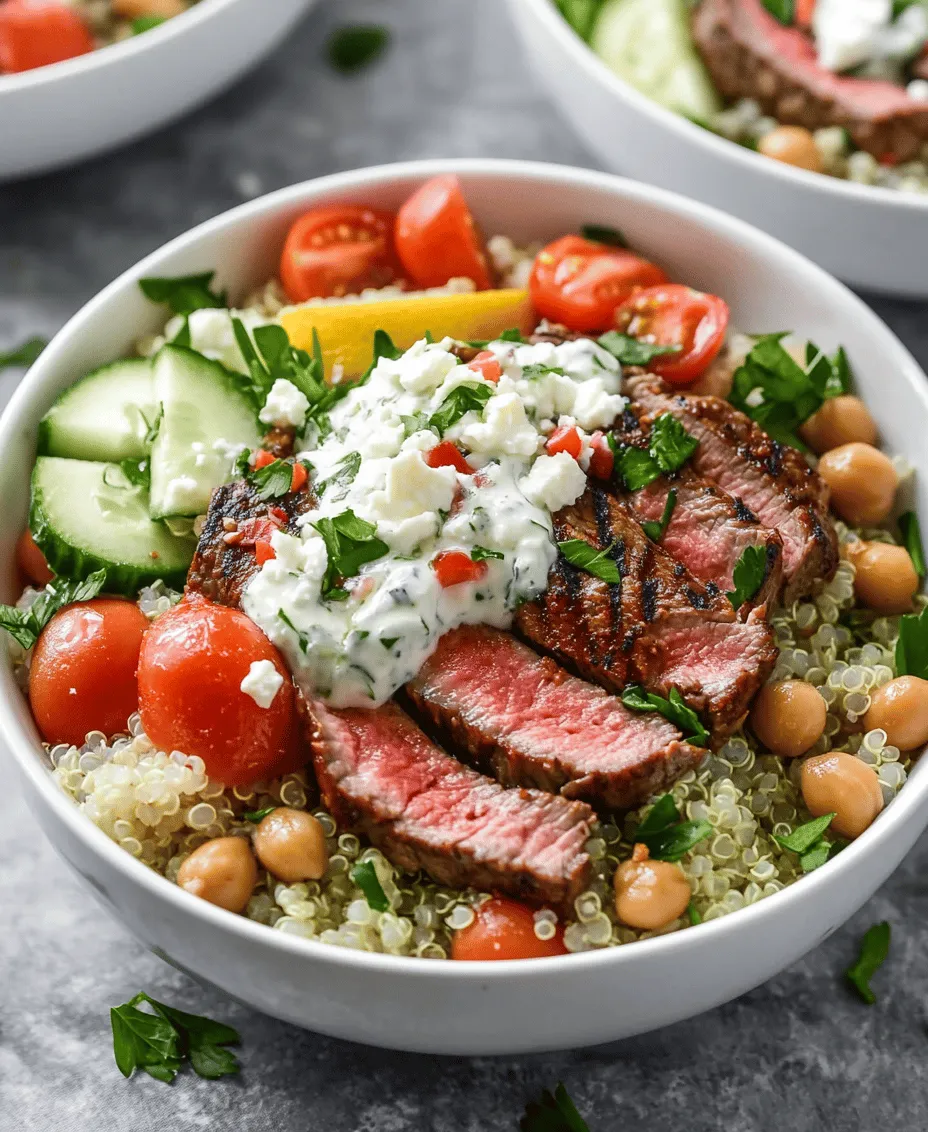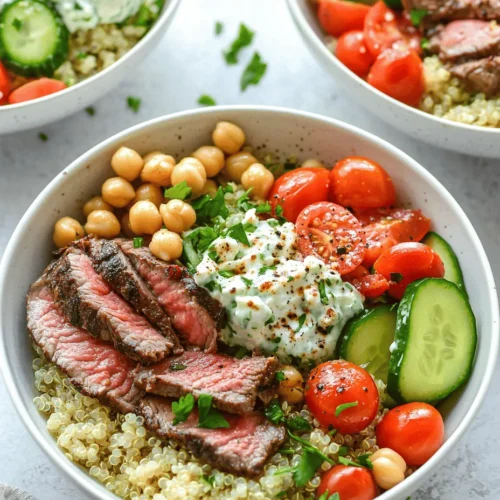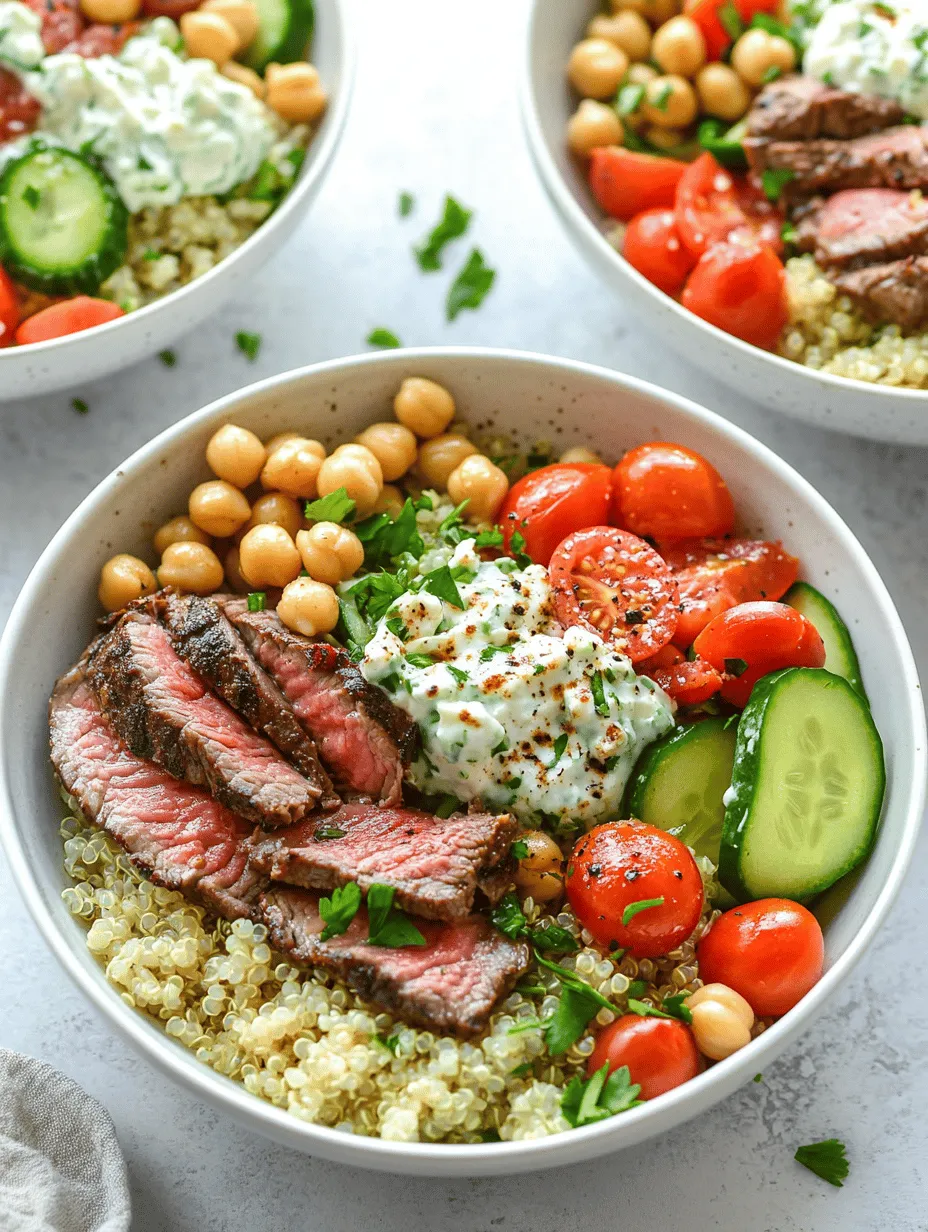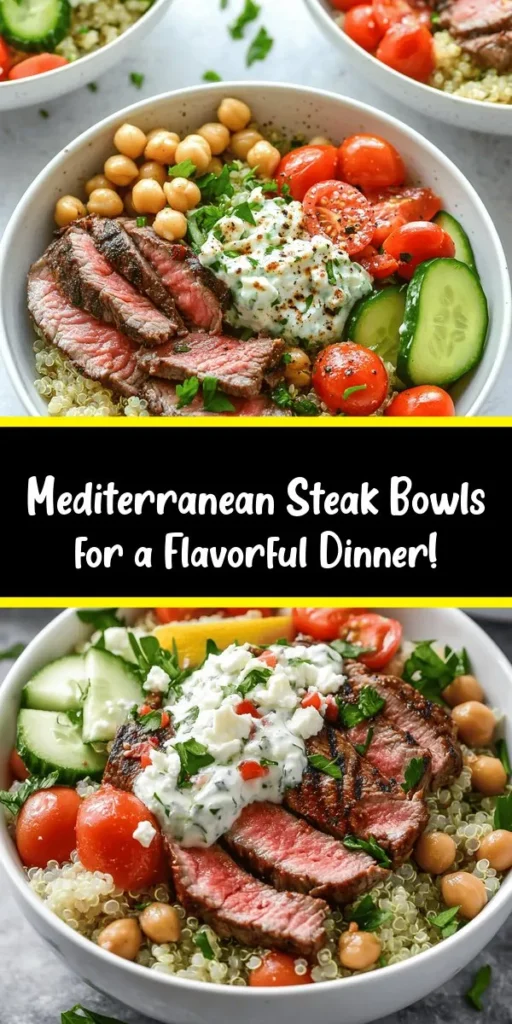Introduction
The Mediterranean diet is widely celebrated for its numerous health benefits, including heart health, weight management, and improved longevity. It emphasizes whole foods, healthy fats, lean proteins, and plenty of fresh fruits and vegetables. This diet is not just about eating healthy; it’s also a lifestyle that embraces the joy of cooking and sharing meals with loved ones. One of the standout dishes that encapsulate the essence of the Mediterranean diet is the Mediterranean Steak Bowl.
Mediterranean Steak Bowls offer a delightful combination of flavors and textures, making them not only nutritious but also incredibly satisfying. They provide a balanced meal featuring succulent steak, hearty grains, and vibrant, fresh vegetables. These bowls are versatile, allowing you to customize them according to your preferences, making them a perfect option for a quick weeknight dinner or a leisurely weekend meal prep.
At the heart of Mediterranean cuisine is the importance of fresh ingredients and robust flavors. Each element in the Mediterranean Steak Bowl contributes not only to the overall taste but also to the nutritional profile of the dish. Whether you’re a seasoned chef or a novice in the kitchen, this recipe provides an opportunity to create a delicious and health-conscious meal that reflects the vibrant culinary traditions of the Mediterranean.
Understanding the Ingredients
To create a truly delicious Mediterranean Steak Bowl, it’s essential to understand the key ingredients that play a vital role in achieving the perfect balance of flavors and nutrition.
The Role of Steak
Steak is the centerpiece of this dish, providing a rich source of protein and essential nutrients such as iron, zinc, and vitamin B12. Choosing high-quality cuts of steak, such as flank or sirloin, can enhance the flavor while keeping the dish relatively lean. The cooking method and seasoning you choose for the steak can elevate its taste, making it a satisfying component of your Mediterranean Bowl.
Health Benefits of Quinoa
Quinoa serves as the base for the bowl, offering a nutritious alternative to traditional grains. This whole grain is not only gluten-free but also a complete protein, meaning it contains all nine essential amino acids. Additionally, quinoa is rich in fiber, magnesium, and antioxidants, making it a heart-healthy choice that aids in digestion and helps maintain stable blood sugar levels. Its slightly nutty flavor and fluffy texture make it a perfect complement to the other ingredients in the bowl.
Nutritional Value of Fresh Vegetables
Fresh vegetables are a hallmark of Mediterranean cooking, and this recipe includes a medley of colorful produce to enhance both the visual appeal and nutritional value of your meal.
– Cherry Tomatoes: Bursting with flavor, cherry tomatoes are rich in vitamins A and C, potassium, and antioxidants like lycopene, which is known for its potential health benefits.
– Cucumber: Refreshing and hydrating, cucumbers are low in calories and high in water content. They provide essential nutrients, including vitamin K and potassium.
– Red Bell Pepper: Sweet and crunchy, red bell peppers are packed with vitamins A and C, as well as antioxidants that support immune function and skin health.
– Red Onion: With a slightly pungent flavor, red onions add a savory depth to the bowl. They contain quercetin, a powerful antioxidant, and are known for their anti-inflammatory properties.
Benefits of Chickpeas
Chickpeas, or garbanzo beans, are a fantastic addition to Mediterranean Steak Bowls, providing a plant-based protein source that complements the steak. They are rich in fiber, which aids in digestion and promotes a feeling of fullness. Additionally, chickpeas are packed with vitamins and minerals, including folate, manganese, and iron, making them a nutrient-dense ingredient that enhances the overall health profile of the dish.
Significance of Herbs and Spices
Herbs and spices are what truly bring Mediterranean cuisine to life. They not only enhance the flavor of the ingredients but also offer various health benefits.
– Parsley: This fresh herb adds a burst of color and flavor while being rich in vitamins A, C, and K, as well as antioxidants.
– Oregano: A staple in Mediterranean cooking, oregano provides a warm, aromatic flavor and is known for its antibacterial and anti-inflammatory properties.
– Cumin: With its earthy and nutty flavor, cumin adds depth to the dish and is also believed to aid in digestion and boost the immune system.
Optional Ingredients: Feta Cheese and Tzatziki Sauce
For those looking to elevate their Mediterranean Steak Bowl further, consider adding feta cheese and tzatziki sauce. Feta cheese introduces a creamy, tangy element that pairs beautifully with the other ingredients. It’s a good source of calcium and can enhance the overall flavor profile of the bowl. Meanwhile, tzatziki sauce, made from yogurt, cucumber, garlic, and herbs, adds a refreshing creaminess that complements the steak and vegetables, making each bite a delight.
Step-by-Step Cooking Instructions
Now that we’ve explored the ingredients that make up the Mediterranean Steak Bowl, let’s dive into the step-by-step instructions for preparing this delectable meal.
Preparing the Quinoa
The first step in making your Mediterranean Steak Bowl is to prepare the quinoa. Quinoa requires a bit of attention to detail to ensure you achieve the perfect texture.
1. Rinsing the Quinoa: Before cooking, it’s crucial to rinse the quinoa under cold water. This process helps remove saponins, a natural coating that can make the quinoa taste bitter. Place the quinoa in a fine-mesh strainer and rinse thoroughly under cold running water for about 1-2 minutes. This step is key to achieving a clean, pleasant flavor.
2. Cooking Methods for Perfect Quinoa Texture: There are a couple of popular methods for cooking quinoa, but the stovetop method is the most straightforward:
– In a medium saucepan, combine 1 cup of rinsed quinoa with 2 cups of water or broth (for added flavor).
– Bring the mixture to a boil over medium-high heat.
– Once boiling, reduce the heat to low, cover, and let it simmer for about 15 minutes, or until the liquid is absorbed and the quinoa is fluffy.
– Remove from heat and let it sit covered for an additional 5 minutes. Finally, fluff the quinoa with a fork before serving.
Cooking the Steak
Next, let’s focus on the star of the show—the steak. Properly cooking the steak requires attention to seasoning and doneness to ensure it remains juicy and flavorful.
1. Seasoning the Steak: Start by patting the steak dry with paper towels to remove excess moisture. This step is important for achieving a nice sear. Season generously with salt, pepper, and any additional spices you desire, such as garlic powder or paprika. Allow the steak to sit at room temperature for about 30 minutes before cooking, which helps it cook more evenly.
2. Cooking the Steak: You can cook the steak using various methods, including grilling, pan-searing, or broiling. For a simple method:
– Heat a skillet (preferably cast iron) over medium-high heat and add a tablespoon of olive oil.
– Once the oil is hot, add the steak to the skillet. Depending on the thickness of the steak and your desired doneness, cook for about 4-6 minutes on each side for medium-rare. Use a meat thermometer to check the internal temperature: aim for 130-135°F for medium-rare.
3. Resting the Meat: Once cooked to your liking, remove the steak from the heat and let it rest on a cutting board for about 5-10 minutes. Resting allows the juices to redistribute throughout the meat, ensuring maximum tenderness and flavor when you slice into it.
With the quinoa and steak prepared, you’re on your way to assembling a vibrant Mediterranean Steak Bowl that is sure to impress. In the next part of the article, we will explore how to assemble the bowl, the finishing touches, and tips for serving. Stay tuned for more delicious insights into creating the perfect Mediterranean meal!

Preparing the Vegetable Salad
A Mediterranean Steak Bowl is incomplete without a vibrant vegetable salad that adds freshness and crunch to the dish. Start by selecting a mix of colorful vegetables to create a visually appealing and nutritious salad. Common choices include cherry tomatoes, cucumbers, bell peppers, red onions, and arugula.
1. Preparing the Vegetables:
– Cherry Tomatoes: Halve them to release their juices and enhance their natural sweetness.
– Cucumbers: Slice them thinly for a refreshing crunch. You could also opt for English cucumbers for a less bitter taste.
– Bell Peppers: Dice them into small pieces for a pop of color and sweetness.
– Red Onions: Slice them thinly to introduce a sharp flavor that complements the steak.
– Arugula: Add a handful to provide a peppery flavor that balances the richness of the beef.
Combining Flavors and Textures in the Salad
Mix the prepared vegetables in a large bowl, ensuring each component is evenly distributed. This combination not only provides a variety of textures—from the crisp cucumbers to the juicy tomatoes—but also a range of flavors that enhance the overall dish. You can also consider adding olives and feta cheese for additional Mediterranean authenticity. The brininess of the olives and the creaminess of the feta will elevate the salad, providing a delightful contrast to the savory steak.
Importance of Fresh Lemon Juice and Olive Oil Dressing
A simple dressing can make or break your salad. For this Mediterranean Steak Bowl, a classic olive oil and lemon juice dressing is ideal.
Dressing Ingredients:
– 3 tablespoons extra virgin olive oil
– Juice of 1 lemon
– Salt and pepper to taste
– Optional: 1 teaspoon of dried oregano for added flavor
Whisk the olive oil and lemon juice together in a small bowl, adding salt, pepper, and oregano if desired. The acidity of the lemon juice cuts through the richness of the steak, while the olive oil adds a silky mouthfeel. Drizzle the dressing over the salad just before serving to keep the vegetables crisp.
Assembling the Bowls
Assembling your Mediterranean Steak Bowl is where the magic happens. Start with a base of your chosen grain, such as brown rice, couscous, or quinoa, which will soak up the flavors of the other ingredients.
Visual Appeal and Presentation Tips for the Bowls:
– Color Coordination: Aim for a balance of colors. Start with a generous scoop of grains, then add the sliced steak, followed by a mound of the vegetable salad.
– Layering: Create distinct layers with each component. This not only looks appealing but allows diners to enjoy each bite as a separate experience.
– Garnish: Finish with a sprinkle of fresh herbs like parsley or mint, and consider adding a wedge of lemon on the side for an extra touch.
Layering Ingredients for Balanced Flavor in Each Bite:
To ensure a harmonious blend of flavors, when layering, place the steak on top of the grains, followed by the salad. This way, the juices from the steak will drip onto the grains, enhancing their flavor. The fresh salad will provide a contrasting crunch, making each bite satisfying.
Serving Suggestions
When it comes to serving your Mediterranean Steak Bowls, think about the overall experience. You can serve them in individual bowls for a family-style meal or create a buffet-style setup where everyone can assemble their bowl according to their preferences.
Ways to Enhance the Dish (Extra Toppings, Garnishes):
– Hummus: A dollop of hummus can add creaminess and a nutty flavor.
– Tzatziki Sauce: This yogurt-based sauce provides a refreshing element that pairs perfectly with the steak.
– Pine Nuts or Sunflower Seeds: Toasted nuts add a delightful crunch and richness.
– Fresh Herbs: Chopped dill or mint can brighten the dish and add an aromatic quality.
Nutritional Analysis
Understanding the nutritional content of your Mediterranean Steak Bowl can help you appreciate its health benefits.
Overview of Nutritional Content per Serving:
– Calories: Approximately 600
– Protein: 35g
– Carbohydrates: 50g
– Fiber: 7g
– Fat: 25g
Caloric Breakdown and Macronutrient Profile:
This meal is balanced with a good mix of macronutrients. The protein from the steak is essential for muscle repair and growth, while the carbohydrates provide energy. The added fiber from the vegetables and grains supports digestive health.
Health Benefits of the Dish:
The Mediterranean diet is renowned for its health benefits, including heart health, weight management, and reduced risk of chronic diseases. The lean protein, healthy fats from olive oil, and fiber-rich vegetables make this dish not only delicious but nourishing.
Comparison with Traditional Mediterranean Dishes:
Compared to traditional Mediterranean dishes such as moussaka or heavy pasta dishes, the Mediterranean Steak Bowl is lighter and more versatile. It allows for a variety of fresh ingredients and can be tailored to fit various dietary needs.
Culinary Tips and Variations
To make your Mediterranean Steak Bowls fit your personal taste or dietary restrictions, consider the following suggestions:
Suggestions for Customizing the Recipe:
– Substituting Proteins: If steak isn’t your preference, grilled chicken, shrimp, or even chickpeas can work beautifully in this bowl.
– Vegetable Variations: Use seasonal vegetables like zucchini, roasted red peppers, or even roasted eggplant for a charred flavor.
Ideas for Meal Prep and Storage for Busy Lifestyles:
– Meal Prep: Prepare the grains and steak in advance to save time. Store the cooked grains and protein in airtight containers and reheat as needed.
– Storage: Keep the vegetable salad separate from the grains and protein to maintain freshness. Store in the refrigerator for up to three days.
Exploring Regional Variations in Mediterranean Cuisine:
Explore regional variations by incorporating spices or ingredients specific to different Mediterranean cultures. For instance, add za’atar for a Middle Eastern twist or incorporate capers and artichokes for an Italian flair.
Conclusion
The Mediterranean Steak Bowls are a wholesome and versatile meal that showcases the vibrant flavors and ingredients of the Mediterranean diet. With a delightful combination of grilled steak, fresh vegetables, and a zesty lemon-olive oil dressing, this dish is not only satisfying but also packed with nutrients.
We encourage you to try this recipe for a flavorful dining experience that celebrates the joy of cooking with fresh, healthy ingredients. Whether you enjoy it as a family meal or a quick lunch, the Mediterranean Steak Bowl is sure to become a favorite in your culinary repertoire. Embrace the goodness of the Mediterranean and discover how easy it can be to create delicious, healthful meals at home.



